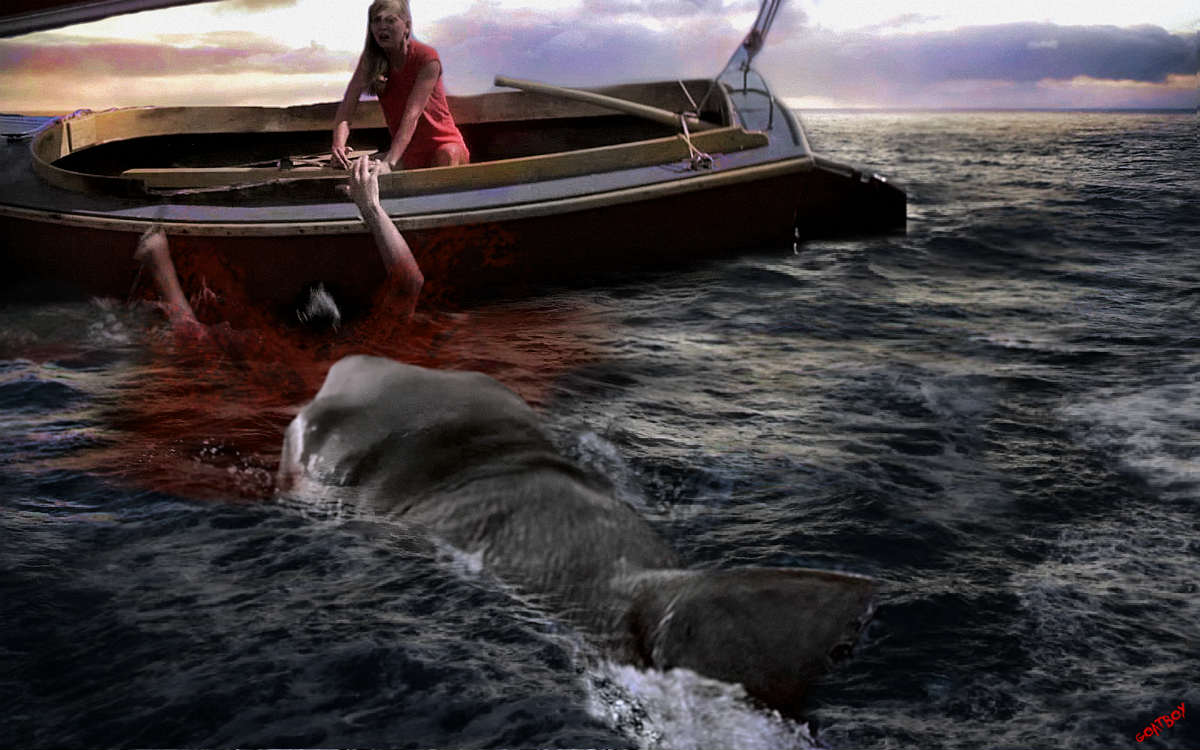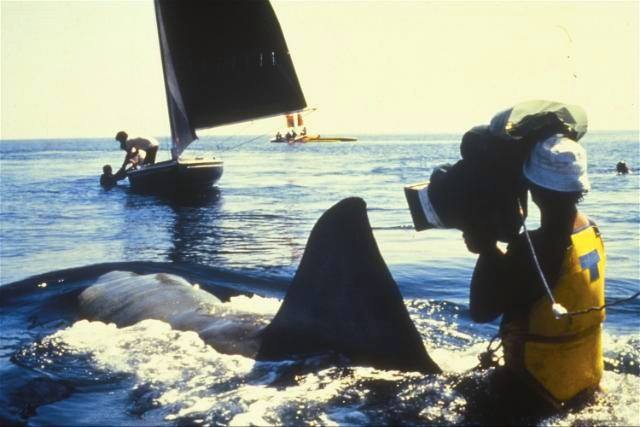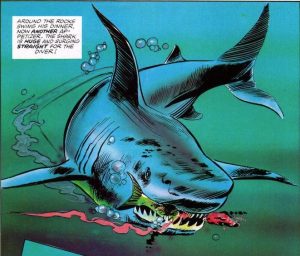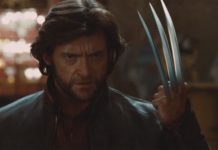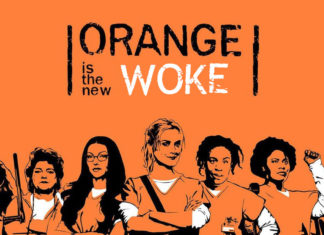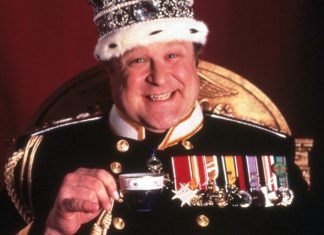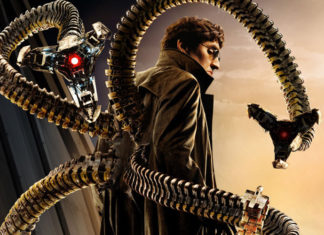How We Got Here
The best laid plans of mice and men… and sharks, and movie producers, directors, writers, actors, midgets… often go awry! Indeed, Spielberg’s seminal movie JAWS, the adaption of Peter Benchley’s summer smash hit novel of the same name, is a massively different story than the one told in the book.
Ch-Ch-Change
Some beats remain the same, as do some characters and motivations. However, other things are changed, adapted, altered beyond all recognition from the novel.
Some of said changes were forced upon Spielberg. Well publicized issues with the mechanical shark and the trials of shooting at sea demanded changes to the script. These were laid out in frantic rewrites by screenwriter Carl Gottlieb and Spielberg himself, the most significant of which required keeping the shark off-screen for much of the movie.
Technical Difficulties
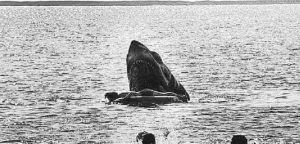
Storyboards show Chrissie Watkins was to be lifted by the pressure wave of the passing shark prior to her attack, giving her pause. Then she was to be rushed from the side with the shark approaching at speed pushing a torpedo like bow wave, as the Nautilus rushes a steamer in 20,000 LEAGUES UNDER THE SEA.
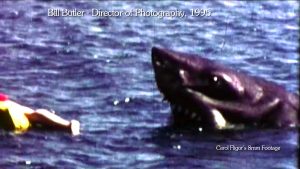
In the Kintner attack the giant beast was supposed to be seen from a crane shot circling under the surface beneath the blissfully paddling child on his raft. Then the shark would almost breach with the young child in its mouth. Aborted attempts at this shot can be found online. The malfunctioning shark consistently refused to behave.
For The Sake Of Story
Others changes were voluntary. Spielberg trimmed the story down by completely removing elements from the novel he felt were extraneous (more on that below).
Brody had three sons in the novel. A sub-plot featuring mafia investment in town real estate, with Mayor Vaughan’s reluctance to close the beaches due partly to him being up to his neck with the mob, is completely removed. An excellent call, as such would have only detracted from the primary (the shark) and secondary (Brody’s family) storylines.
The most notable departures Spielberg took in altering the story was not only his different take on the Brody family dynamic, but on the character of the residents of Amity Island itself. Where it’s only hinted at in the movie, with the conversation on the beach immediately prior to the Kintner attack, in there is a high degree of snobbery among Amity residents who are well to-do with hints of older money. Amity is not an island. It is a Long Island resort with a touch of The Hamptons around it.
While Brody’s wife Ellen is of the “right set”, her standing has been eroded by her marriage to this local sheriff. Both she and Brody are aging but she is yet an attractive woman, acutely aware of missed opportunities, and resentful of her peers who refused to surrender their social status for true love.
In turn, Brody feels inadequate, aware he will never be one of the Amity set; aware that he married above his social status. These contradictions in status result in a palatable tension in their marriage. This dynamic is a far cry from the stable, honest and strong family Spielberg presents us.
Into this arena steps a very different Matt Hooper. Young, dashing, tanned, lean with long blond hair of the popular style in the 70s. Hooper was originally planned to be played by a young Jan Michael-Vincent in his pre-Airwolf prime. He is the little brother of an ex-boyfriend of Ellen’s. He is of the right set, being from old Long Island money. His expertise juxtapose with an increasingly out of his depth Brody.
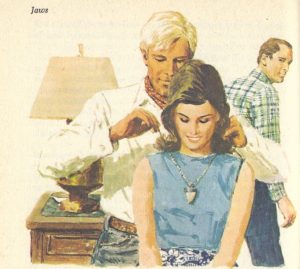
Hooper’s antagonism with Brody, and his crush on Ellen from their previous life, combine with Ellen’s increasing regret for her lost past. This leads to a brief sexual affair between Hooper and Ellen. Brody suspects and plans to confront Hooper. However he never gets the chance as Hooper’s foray into the shark cage from the Orca at the climax ends very badly for Hooper compared to his narrow escape in the movie. Spielberg decided to exorcise this entire subplot, claiming it made all the main characters so unlikable that he was rooting for the shark!
Hooper’s death was never filmed. This was partly due to the malfunctioning shark. It was also due to midget stuntman Carl Rizzo (brought in to lend the very real Great White used in some footage the enormous scale of the Benchley shark) overestimating his bravery, which failed him when the real shark became entwined in the cables holding his cage during an attempt to capture this sequence. He refused to re-enter either water or cage again, requiring another hasty rewrite resulting in Hooper’s miraculous escape.
Ultimately, the sum of these changes (whether by design or accident) coalesced to create one of the greatest movies ever made. One that electrified audiences, supercharged the box-office and invented the concept of the summer blockbuster, in turn creating an instant demand for a sequel. Production on the sequel would have an even more troubled history than the original: the evolution from screenplay to finished product very nearly a completely different movie from what ended up on screen.
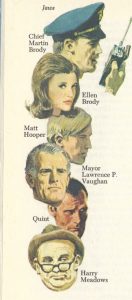
Return to Martha’s Vineyard
The moment the scale of JAWS success became apparent at the studio, plans for a sequel were set in motion. Spielberg was offered this but JAWS had opened doors to him and a long gestating passion project, CLOSE ENCOUNTERS OF THE THIRD KIND, became his first priority. Interesting to note, at the time he regarded sequels as “A cheap Carney trick.” A view he changed, via a hefty paycheck, for Indiana Jones. His memories of the troubles he had during JAWS production convinced him to step away from the emerging franchise. The troubled production would eventually reach out to him again. While he came close to returning to direct it as a prequel (about Quint surviving the sinking of the USS Indianapolis), he ultimately declined to do so.
Just When I Thought I Was Out
Roy Scheider, only returning due to a contractual wrangle with Universal, would return to reprise his role as Chief Martin Brody. Murray Hamilton and Lorraine Gary returned as Mayor Vaughan and Ellen Brody respectively. Richard Dreyfuss was kept busy by Spielberg at Devil’s Tower in Wyoming, preventing the character of Hooper from returning.
Spielberg’s unavailability and unwillingness to return led to John D. Hancock stepping in to direct a script written by his wife, Dorothy Tristan. This script had a completely different outlook, tone and plot in contrast to what ended up on the screen. The screenplay was completely at odds with what Universal wanted, and when the first rushes were viewed they (Universal) were horrified.
Their desire for a rollicking action adventure follow-up to the first movie was at odds with the screenplay and production. Hancock and his wife had their own vision of where this story needed to go. Struggling with the demands of a high profile, high budget Hollywood production, the suits at Universal paused production, summoned the director and writer back to the studio and fired them.
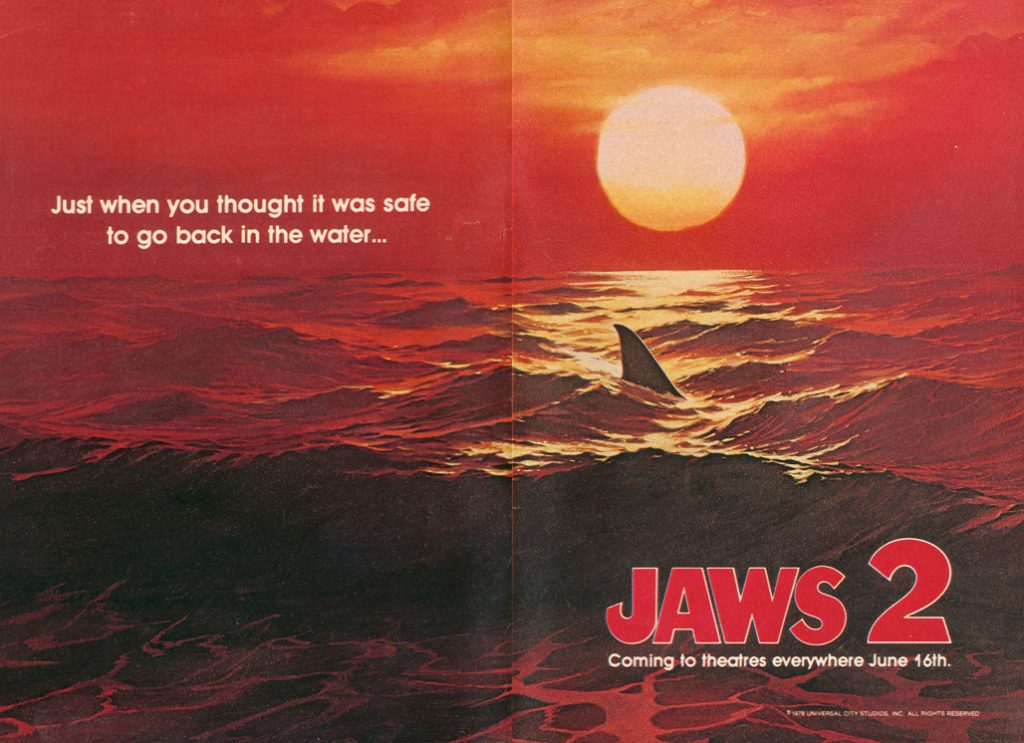
Back to the Beginning
Carl Gottlieb, superhero script editor and screenwriter from the first JAWS movie, swung into action. Jeannot Szwarc was brought in to direct. The production was still troubled but this article is not about that, it’s about what might have been.
All that remains of John D. Hancock’s work in the finished movie is a single, marvelous shot: Amity harbor [night] birds [explode] from the water along the shoreline in instinctual panic. The tiller on a yacht swings as something large moves past the rudder. A shadow can just be seen beneath the surface before finally a fin emerges from the water heading towards the shore.
The quality of this brief sequence, and it’s dark, atmospheric mood, give us a tantalising glimpse of what we nearly got. Further evidence can be found in early versions of the script based more closely on Tristan’s treatments. The Marvel comics adaption printed very early in production brings some of these sequences into vivid, full color life. The most descriptive evidence is available in the excellent novelization by Hank Searls, likewise based on very early drafts.
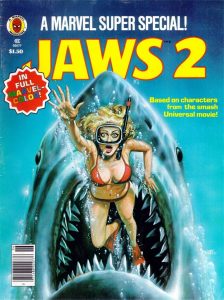 A Very Different Tale
A Very Different Tale
Two weekend divers, doctors out from Rhode Island, are on a boys weekend on a boat they co-own. They have indulged in too much whisky and a few pills to steady the nerves. They wonder what the town they can see from their boat is called. They check their charts. They have heard of this town. A memory, something on the news a while ago. It’s only when, during their dive, they discover the wreck of the Orca that they suddenly remember. All too late, as their dive is interrupted by…something.
Meanwhile
Amity is dead. A ghost town.
The Troubles, as the locals refer to the shark incidents, have ripped the heart out of the town and left the local economy in tatters. Shops are shuttered. Summer homes remain un-rented. Business have folded and the welfare bill is astronomical.
However there remain two small signs of hope. The first, a new water-sports retail business recently opened by ex-Navy diver Tom Andrews. A bearded giant of man from California who has moved to Amity to open his shop, launch his dive school, and (eagerly) play a part in his local community. He has befriended the Local Chief of Police, Martin Brody, and the two of them have the town’s best interests at heart.
The second factor at play is the new development of condos and beachfront villas– complete with hotel– in the Amity Shores development. All this is being bankrolled by developer Len Petersen and will include a casino subject to a gaming license being approved by state legislators up in Albany.
Both developments have given the town hope and started to drive visitor numbers up again. The town’s young teenage population is showing signs of going Scuba mad, and Mike Brody is enamored with his new hobby. As the closed water sessions of Andrews’ inaugural scuba school draws to a close in the town pool the open water part of the training looms. Brody is having a crisis of confidence and is yet to sign the permission slip.
To Note
This early version of Brody is different from the one in the finished movie.
He is a more haunted man. The memory of what happened in front of him on the Orca has left him with what, at times, seems close to a form of PTSD. The things he experienced, the burdens and memories he carries from The Troubles and the Orca cloud his thinking and shape his actions. He still carries guilt from a failure to drive through the beach closures after Chrissie died, so still feels responsible for the other deaths. Alex Kintner among them.
Despite this anxiety, he is not paranoid; not fearful of a shark around every shoal. He is still a functioning human being.
Yet thoughts of other sharks do enter his mind, though he rationally dismisses them. The missing diver’s boat is found to contain many empty bottles of grog and plenty of evidence of the pills. So their disappearance is put down to diving negligence. A view Tom Andrews supports as he disapproves of drinking and diving.
Then a man and his wife disappear on a water-skiing trip.
The attack is more visceral with the shark hitting his wife again and again then turning on the boat. He shoots the flare gun as it rams the speedboat and the force causes him to miss and fire directly at the spare gas tank to cause the explosion. No pouring of fuel or a fire-scarred shark here.
Of course, this also looks like a tragic accident, and Brody must discover what caused the explosion. This leads him not to a re-emergence of toothy terror, but instead to a fellow policeman.
A holidaying NYC cop was shooting his rifle at a seal pup that was causing his dog to over-react in front of his beach house. He has hit the seal once but claims it was an accident and he was shooting near it in order to scare it away. With a mysterious explosion offshore, Brody starts to put two and two together.
Classing the seal as evidence, it ends up living in Brody’s garage where a young Sean Brody adopts him and names him Sammy. Sean is only distracted from his care-giving duties by a cod run into Amity harbour the likes of which people have never seen before. Happy pier fisherman don’t stop to wonder if something is spooking the local cod population as they enjoy their bounty.
Breakdown Of Disbelief
This whole story neatly sidesteps one of the inherent problems with JAWS 2 as it was presented in the final version on screen – Brody is a hero who helped slay the beast. He was right all along. When he suspects another shark is in the area people make all the same mistakes they made in the first movie. How could they be so stupid?
In this version we know the truth. We know that two divers didn’t over drink and pop pills. We know the boat explosion wasn’t a tragic accident and that it wasn’t some trigger happy NYC cop shooting up the beach that caught the boat with a stray shot. We know why a seal has beached and doesn’t want to go back in the water. We know why the cod are running in Amity harbour. But Brody is not making the connection, and so we are spared a re-run of various townsfolk not listening to him as per the final movie. Instead we follow Brody, and Andrews, and Vaughan and Ellen as their stories reach the final conclusion we’ve seen coming all along.
But before the inevitable reveal, Brody is driving hard on an investigation. He wants to prove the mouthy NYC cop, shooting up his beach, clipped the boat and caused the explosion. He also ruminates on whether the cop might have taken some pot-shots at divers, separated from their boat, emerging from the surf looking like seals in their dark wetsuits.
All these thoughts enter his mind as he drives home in the dusk along the coast road and spots something bobbing in the surf. His fear of water needs to be conquered as he wades out to retrieve what turns out to be a portion of the gas can from the boat with a hole in it. The cheap jump scare of the movie is replaced by him being unknowingly and unseen stalked by the shark which is just offshore but unable to get to him due to the shallow water.
With his theory of the cop on the beach causing the boat explosion looking proved, he engages forensics on the mainland to seal the deal and arrests the cop. This sets in motion the second of the three major subplots.
Len Petersen isn’t the only casino backer. Dusting off a subplot from the Benchley original novel that didn’t make it into Spielberg’s movie, the mafia are involved. Their money is on the line. Brody’s arrest of a fellow cop, who turns out to be connected upstate, has made waves up in Albany and the gaming licence is being looked at very closely. This jeopardises their entire stake in Amity Shores and Petersen is furious. Word comes down from the top that this upstart small-town police chief needs to be dealt with.
Brody, however, has something of a guardian angel. Tony Moscotti, a senior figure in the NYC crime families, has a summer house in Amity. When the town was keeping Moscotti and his family at arms length, acting cold towards them because of their criminal connections, Ellen Brody let Moscotti’s eight year old son join the Amity Cub Scout pack. Arguing with both Brody and other selectmen that the shady character of Moscotti should not be allowed to impact an eight year old boy who needs summer friends, she has overruled their wishes.
Moscotti has never forgotten this act of kindness towards his son. Because of this he tries to lean on Brody to drop the charges against the NYC cop. This indirectly protects him from some of the Mob’s worst characters who wouldn’t think twice about whacking this two-bit small-town Chief.
The third subplot also comes into play at this point. A naval exercise is underway in Amity Sound.
Mike Brody is teased mercilessly by Larry Vaughan, son of the Mayor, about his aqua phobia after the town pond attack in the first movie. On the beach he is subjected to being named “Spitzer” after the Olympic legend. The inference is that he is good in a pool, and only a pool. Already sensitive about his upcoming open water diving training with Tom Andrews and nervous about having to take his training out of the town pool, he snaps.
Brody chases Vaughan into the sea and swims him down in deeper water, then proceeds to fight him and hold his head under the surface. This commotion out past the breakers and over the ocean drop-off has attracted the attention of a passing naval helicopter on a sonar dipping exercise. It has also attracted the attention of the shark.
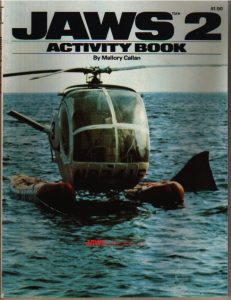
Mike Brody becomes the second member of the family to narrowly avoid becoming shark food without knowing it when the shark is distracted by the rhythmic thrumming of the chopper and the dragging sonar buoy.
In a sequence that was clearly the genesis of the more overt helicopter attack in the movie, the shark switches targets from the splashing youths to the helicopter and sonar buoy.
The sudden jerk causes blade vibration and auto-rotation issues for the helicopter which dumps the buoy and attempts to limp home, only to crash into the sea several miles away. The boys, unaware of this or how close they came to an attack, return to shore.
This launches a naval search for a downed crew – the sole survivor of which is taken by the shark while floating in a life jacket shortly after the crash – and the dumped sonar buoy. Brody helps liaise with the navy and the offer of a reward for the location of the buoy causes excitement in the town. Especially excited are the inaugural scuba class who want to put their new-found underwater skills into finding the object and claiming the booty.
At this point the whole story kicks up a gear and accelerates toward a finale at breakneck speed that involves all the threads beginning to tie together before Brody has to be dispatched, once more, to face down his worst fear on the water.
The situation with the Mob has escalated. The ballistic forensics come back and prove that Brody is wrong. The cops rifle couldn’t have caused the damage to the fuel tank and all evidence points to a very-pistol type flair gun. Brody knows when he is beaten and drops the charges.
This means the anger of Mob switches to focus on the NYC cop who was connected to them upstate. He brought all this attention on the gaming licence they need to get their investment in Amity Shores to pay out. He tried to defend himself via a Mob lawyer. He is a liability and he is dealt with. This leads to a nice little scene in which the cop is plugged by a hitman at night on the beach and when he disposes of the body in the sea, both he and the body are taken by the shark.
The divers camera has been recovered and is developed, but not by Brody as in the movie. The town pharmacist has the picture that shows the shark in all its glory in this iteration. He presumes Brody lied about killing the shark and it’s the same as the one in The Troubles. Rather than speak out he keeps quiet while he puts his business up for sale, knowing the shark would cause property value in the tourist town to crash even further. His shenanigans with the local property market also bring him into contact with the Mob, and an attempted blackmail leads to a violent misunderstanding that doesn’t end well for him, taking his secret to the grave.
The shark remains an undetected threat when Mike Brody conquers his fear to take part in the open water training for his Scuba course. In a scene which bears similarities to some points in the theatrical movie he is separated from his dive buddy, his fat friend Andy. Andy finds the abandoned sonar buoy. He also encounters the shark.
In a panic, the untrained Andy bolts for the surface causing an embolism. He is pulled from the water and returned to shore. Before being taken to hospital by ambulance he is only able to mutter and moan from the gurney “Shhhhh…Shhhhaaa….” This line was taken by a terrified Tina in the movie, after the attack on her boyfriend.
Unable to speak properly due to encroaching paralysis, the warning is not conveyed or understood.
Tom Andrews and Brody assume that he found the sonar buoy and surfaced too fast in excitement. So they set off on Andrews boat. He feels responsible as Andy was in his class so wants to find the buoy, claim the reward and use it to pay Andy’s medical bills.
Meanwhile across the bay, the Cub Scouts have a boat in the annual Amity Regatta with Moscotti Jr and Sean Brody among the crew. The towns youth are sailing and racing when the Amity fog descends. The race is aborted but the leading boats, including Sean’s, do not hear the recall horns and continue on. Trapped in a fog bank and unable to navigate back to shore, and with night falling, they raft up their boats and await rescue.
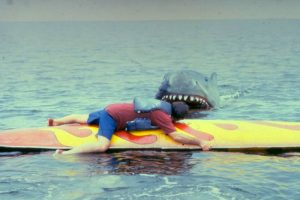 Brody and Andrews encounter the shark, finally letting things fall into place for Brody right at the end of the story. He then takes off to rescue the children, leading to the inevitable confrontation. This includes a certain electrical cable that the kids snagged one of their anchors on.
Brody and Andrews encounter the shark, finally letting things fall into place for Brody right at the end of the story. He then takes off to rescue the children, leading to the inevitable confrontation. This includes a certain electrical cable that the kids snagged one of their anchors on.
Rather than the entirety of act 3, the kids in peril section is mere pages at the very end of both the early script and the novelisation.
There are a number of other nice touches that weave through the story that was binned in favour of the Gottlieb rewrite.
The shark is a female, the mate of the male from the first Jaws. She has only returned to the area where she was first mated with in order to give birth. She is fat, slowing down, gravid with young and ravenously hungry as she patrols Amity. This leads her to be more aggressive and willing to investigate anything that might be food.
There is an attack on a seal, and an attack on a trained naval dolphin that is involved in the search for the missing sonar buoy from the downed chopper. These show the danger the shark presents without overloading on human attacks. It also adds to the villain score, when chomping on cute and lovable aquatic creatures.
Both of these facts combine to help make the tale feel more anchored in the natural world rather than just about a marauding shark with an instinctual need to eat humans.
The townsfolk get some more colour added to them. Other Amity Selectmen feature. Harry Meadows makes a return. Mayor Vaughan is a more sympathetic character. Ellen is a strong emotional centre for Brody.
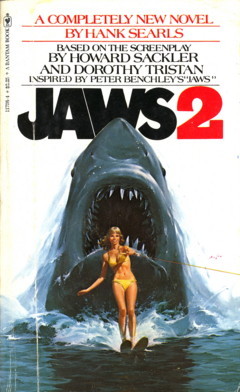
However the crowning achievement for me is just how different a direction it manages to take from the finished movie. In the story as laid out in Hank Searls 238 page book, based on the original script, it is only on page 212 that Brody finally learns he has another shark problem.
Searls novelisation can be found for pennies in online second hand book stores. It is well worth checking out.
For his next trick he would go even further. Searls would prove that it is, in fact, possible to polish a turd. He does the unthinkable in turning the awful JAWS : THE REVENGE into a rollercoaster of a novel involving Caribbean drug lords, island politics, voodoo magic and parental revenge, all with a large Great White Shark swimming in and out of the plot.

